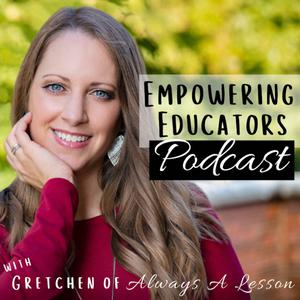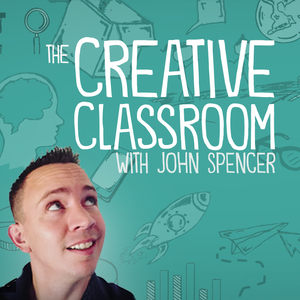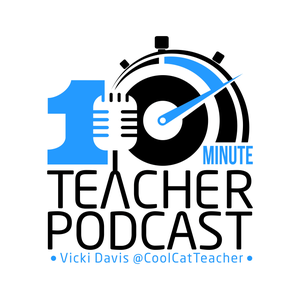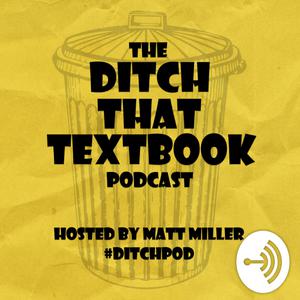
The Spark Creativity Teacher Podcast | Education
Betsy Potash: Education Blogger + Curriculum Designer
Creative and Quick Classroom Ideas for English teachers
- 5 minutes 22 seconds298: This Shakespeare Podcast connects the Bard to Modern Life
Links Mentioned:
Today I want to talk about a fantastic podcast for you to use in class if you teach Shakespeare. With dozens of intriguing episodes like "Shakespeare and Game of Thrones," "Shakespeare and YA Novels," and "Pop Sonnets," The Shakespeare Unlimited Podcast, by the Folger Shakespeare Library, is a great way to bring in modern connections and relevancy to whatever play you're studying. Today I’ll give you a quick rundown on four fun episodes, and then I hope you’ll go exploring on your own to find more episodes that could help your students make connections between your chosen Shakespearean text and modern life.
In “Akala and Hip Hop Shakespeare,” Akala explores how the rhyme and rhythm of Shakespeare as well as the deep meaning relates to the same components of hip hop. He talks about the traditions of music flowing out of Africa and into the diaspora, and also brings up questions of who education is for and how Shakespeare came to be associated with elite society.
In “Shakespeare and YA Novels,” two novelists talk about how they have used Shakespeare’s work to inspire their own, and how they felt connecting themselves to someone so renowned.
In “William Shakespeare’s Star Wars,” one author explains how and why he came to rewrite the Star Wars series in Shakespearean language. Bet you didn’t see that one coming!
And in “Pop Sonnets,” a popular online writer shares the story of how he came to rewrite pop songs as Shakespearean sonnets. And spoiler alert, they sure did become a sensation!
When integrating episodes like this into class, try giving students a sketchnotes template to provide a little loose structure as they listen. Let them know how you’ll be using the text moving forward, so they have a reason to pay attention. Maybe it’s going to lead into a writing activity, a silent discussion, or a mini-podcast project of your own!
Shakespeare can sometimes feel far away to students, but Shakespeare Unlimited helps bridge the gap. That’s why this week I want to highly recommend you hit follow on their feed and see what wonders you discover.
Sign up for Camp Creative Here: https://sparkcreativity.kartra.com/page/camppodcasting2024
Explore the Shakespeare Unlimited Podcast: https://www.folger.edu/podcasts/shakespeare-unlimited/
Go Further:
Explore alllll the Episodes of The Spark Creativity Teacher Podcast.
Join our community, Creative High School English, on Facebook.
Come hang out on Instagram.
Enjoying the podcast? Please consider sharing it with a friend, snagging a screenshot to share on the ‘gram, or tapping those ⭐⭐⭐⭐⭐ to help others discover the show. Thank you!
16 May 2024, 1:24 pm - 10 minutes 29 seconds297: How to Squeeze Choice Reading into ELA (even if it feels impossible)
Choice reading can sometimes feel like an out-of-reach dream. I recently heard from a busy teacher who wrote, "I love choice reading, but squeezing it in can be tough!"
Yeah, I get that. There's so much going on in ELA.
In today's episode, we're talking about how to squeeze more choice reading moments into your busy schedule. Even if you don't have time to hand over 10 minutes in class for reading regularly, you can still build your choice reading program with quick-and-easy additions like these.
Links Mentioned:
Sign up for Camp Creative Here: https://sparkcreativity.kartra.com/page/camppodcasting2024
Go Further:
Explore alllll the Episodes of The Spark Creativity Teacher Podcast.
Join our community, Creative High School English, on Facebook.
Come hang out on Instagram.
Enjoying the podcast? Please consider sharing it with a friend, snagging a screenshot to share on the ‘gram, or tapping those ⭐⭐⭐⭐⭐ to help others discover the show. Thank you!
14 May 2024, 12:47 pm - 5 minutes 4 seconds296: My Favorite Final Exam (I mean, not that I don’t love Multiple Choice)
Today I want to talk final exams, and specifically, one I’ve really enjoyed giving when I had the leeway to skip the sit-down exam. If you don’t have to involve any Scantron sheets in your final, you might love it too, so let’s dive in.
Maybe you’ve seen some of the great graduation speeches floating around the internet - maybe you even analyze some of them with your students when you’re teaching public speaking or rhetorical devices. I haven’t had time to dive in yet, but I hear good things about Jason Reynolds’ speech at Lesley University and Taylor Swift’s at NYU.
But for this project, the wisdom that will be on offer won’t come from celebrities. Nope, instead, your students will take the podium and give their own graduation speeches, based on the wisdom they can pull from what they’ve read in your class.
Have your students look back at your texts and themes in the context of three out of the following four main ideas.
How literature helps people understand their own lives.
How literature helps people understand the lives of others and empathize with other people.
How literature makes it easier to understand history.
How literature illuminates issues of morality.
This little bit of structure makes it a lot easier to organize their final speech. What I love about this is that what we’re really asking them is: why do we read? Why did this class matter? For me, that’s a really important way to end the year, and I love hearing what they say.
I suggest you have your students present their speeches during the exam period. Meet outside somewhere, like the baseball bleachers, or reserve the library or a special room if you have that option. Then either have all the students read their speeches or divide into groups and have them read to their small groups. I like to give them a listening handout for this day, in which they nominate the best speeches and defend their nominations.
When it comes to exam time, I’m all for trying something that better reflects the goals of your course than a multiple choice exam. Whether it’s a graduation speech or something else, this week I just want to highly recommend that you reach out to your admin and request this option, if you don’t already have it!
Sign up for Camp Creative Here: https://sparkcreativity.kartra.com/page/camppodcasting2024
Go Further:
Explore alllll the Episodes of The Spark Creativity Teacher Podcast.
Join our community, Creative High School English, on Facebook.
Come hang out on Instagram.
Enjoying the podcast? Please consider sharing it with a friend, snagging a screenshot to share on the ‘gram, or tapping those ⭐⭐⭐⭐⭐ to help others discover the show. Thank you!
9 May 2024, 1:10 pm - 11 minutes 56 seconds295: Revision Frustration? Try This.
Do your students think of the revision process as a combo of spellcheck and Grammarly? Tend to peer edit by scrawling a compliment and circling two sentences that are missing periods?
Yeah, they're not alone. Honestly, I didn't really get the revision process as a student either. It sort of felt like I wrote the paper I was going to turn it in, then I'd "polish" it a little by fixing any tiny surface mistakes so I could turn it in.
Students are busy people, juggling family, friends, sports, classes, jobs, the college admissions process, and a complicated world of digital social life that we probably only barely understand.
So unless we can really spell out the revision process for them, they're likely to think the pretty good paper they felt they wrote in the first place is pretty good enough to turn in.
That's why today on the podcast I'm going to offer you four blueprint options for helping them do better. Choose the one you love, or try all four.
Before we get started, I want you to know that I’ll be running Camp Creative, The Easiest Roadmap to Student Podcasting, in June. Inside this (free) and fun PD, you’ll get access to the best models, easiest tech, and complete curriculum to get you and your students started with podcast projects. Everything arrives by email, so even if you’re busy the week of June 10-14, you can catch up whenever you get a chance. It just takes 10 minutes a day to go through the materials
Links Mentioned:
Sign up for Camp Creative Here: https://sparkcreativity.kartra.com/page/camppodcasting2024
Snag your Copy of the Revision Challenge Cards: https://docs.google.com/presentation/d/125AkbMNA_52WdNxbF2ryvc44UUOi5WOwkFF6CG45BvI/copy
Grab the Peer Editing Guides: https://nowsparkcreativity.com/2018/11/the-ela-teachers-quick-guide-to.html
Go Further:
Explore alllll the Episodes of The Spark Creativity Teacher Podcast.
Join our community, Creative High School English, on Facebook.
Come hang out on Instagram.
Enjoying the podcast? Please consider sharing it with a friend, snagging a screenshot to share on the ‘gram, or tapping those ⭐⭐⭐⭐⭐ to help others discover the show. Thank you!
7 May 2024, 2:23 pm - 7 minutes 33 seconds294: Crying in the Dusty Stairwell (on Hitting a Wall in Teaching)
Today I want to talk about a subject I’m sure you’ve thought a lot about - how much are you willing to do for your job? And what do you do when you’ve hit your wall?
I want to start by taking you to the dusty steps of the duplex I shared during my first year of teaching. It’s dusk, and I’m crying. I recently won the award for excellence in new teaching at my school, receiving many hugs and congratulations, as well as a raise and kind compliments from my head of school. I should be feeling great, right? I had discovered so much that year in my quest to engage my 10th and 11th graders - how to run Harkness discussions, hold poetry slams, launch play performances, find the gold on the teaching shelves of the Los Angeles Public Library. I had given it everything, and truthfully it had given me a lot back.
But I was thinking of quitting.
Utterly exhausted, I sat on those steps wondering if I could possibly continue in a career that took this much. Could I continue to work from 7 am to 10 pm? Could I continue to think about my job everywhere - in the car, with my friends, at the beach? Could I find love and family if I was always in my classroom, the dorm, or coaching on the tennis court?
Wiping my eyes, I ran up those dusty stairs and into my office to find a piece of paper. I made a list of 23 rules for myself. The boundaries I would have to hold if I wanted to continue in the career I loved. I took everything else off my bulletin board and put the rules in the middle.
Then, I stayed in teaching. And though honestly I’m not sure I was ever better at it than that first year when I made it my whole life, I found that my boundaries helped me enjoy my work as a creative teacher for many years.
Until one night almost a decade later. It was nearly midnight and I had had THE WORST day. Up early to prep something or other, then racing from class to class all morning before taking my advisees out for a special lunch that had been requested by my residential life boss which made me late for a lunch meeting with my 10th grade honors students participating in the portfolio program that had been requested by my academic boss. Then more classes, coaching, a school dinner, an evening of working in the dorm and I was home at 11 with some work to do for the next day. I stared and stared at my computer screen as the rage built up in my mind and eventually led me into my email inbox to open a note to my head of school.
You can probably imagine it. I kind of wish I still had it. I just let allll my feelings out, which isn’t very common for me. I woke up to a response inviting me to a meeting right away.
My rage having subsided a bit, I felt awkward when I walked into that wood-paneled office in the administration building. Nothing helps you tap into how you really feel better than a 16 hour workday, and I told my head of school I wasn’t sure I could really capture it all again. He laughed a little awkwardly and said the email did a very good job. We talked for a while, and in the end, he took a huge part of my spring workload off my plate.
OK, so these are two very different stories about the same thing. Hitting the wall. Thinking about leaving the profession. I can’t pretend to know all the circumstances you’re facing right now, but I’m seeing a lot of folks in our community struggling. If you’re hitting a wall like I have, for reasons of your own, see if you can tap into your feelings and try to create a pivot point.
It could be personal - like my list of boundaries. Maybe instead of quitting, you radically change how you grade, refuse to give up your prep period, stop agreeing to join committees, only check email twice a day, and commit to taking weekends off.
Or it could be a line you ask to draw in the sand with your boss - like my midnight letter (though I suggest you approach it more coherently than I did). If you need a change, is it possible you could get one through a letter or a very serious conversation with someone at your school, rather than a new job? If you want to stay but you’re thinking of leaving, is it at least worth a try?
I want to see you enjoying your creative classroom and loving your work, and I know there are a whole lot of societal factors making that really hard right now. If you’ve hit a wall that can’t be overcome, I get that. Maybe you want to transfer your amazing skills to another path. But if you want to be in the career you’re in, but you too have cried in your own version of the dusty stairwell and questioned everything at the end of your own version of the unbelievably overwhelming day, maybe there’s a step you could take toward change. And this week I just want to highly recommend that you take it.
Sign up for Camp Creative Here: https://sparkcreativity.kartra.com/page/camppodcasting2024
Go Further:
Explore alllll the Episodes of The Spark Creativity Teacher Podcast.
Join our community, Creative High School English, on Facebook.
Come hang out on Instagram.
Enjoying the podcast? Please consider sharing it with a friend, snagging a screenshot to share on the ‘gram, or tapping those ⭐⭐⭐⭐⭐ to help others discover the show. Thank you!
2 May 2024, 12:56 pm - 9 minutes 57 seconds293: Creative Exam Review Activities for ELA (that don't involve a packet)
With exam season coming up, you're probably looking for some creative ELA review activities.
Whether your school requires that students sit a traditional exam, or you have room for something like the graduation speech final or another type of final project, it's helpful to look back over the big concepts, themes, and texts you've covered as the year draws to a close.
So what options do you have besides printing out a 20 page review packet and giving students time to study it? A lot, as it turns out. Today we're going to explore five of them, in hopes that you'll find a match that feels just right to you.
Before we get started, I want you to know that I'll be running Camp Creative, The Easiest Roadmap to Student Podcasting, in June. Inside this (free) and fun PD, you'll get access to the best models, easiest tech, and complete curriculum to get you and your students started with podcast projects. Everything arrives by email, so even if you're busy the week of June 10-14, you can catch up whenever you get a chance. It just takes 10 minutes a day to go through the materials!
Links Mentioned:
Grab your Copy of the Review Quiz Game Here: https://docs.google.com/presentation/d/1s2HlNyX8Zh9_WYnJsZmTgbbLvGjewzhDnAn8aPgXg2U/copy
Sign up for Camp Creative Here: https://sparkcreativity.kartra.com/page/camppodcasting2024
Go Further:
Explore alllll the Episodes of The Spark Creativity Teacher Podcast.
Join our community, Creative High School English, on Facebook.
Come hang out on Instagram.
Enjoying the podcast? Please consider sharing it with a friend, snagging a screenshot to share on the ‘gram, or tapping those ⭐⭐⭐⭐⭐ to help others discover the show. Thank you!
30 April 2024, 9:50 am - 4 minutes 29 seconds292: Try the Sesame Street Quiz (5 Different Ways)
Today, I want to highlight a useful tool Amanda Cardenas shared earlier this year on the show called The Sesame Street Quiz. It’s so versatile, so fun, and so helpful that I feel it deserves a show of its own, so here we go.
Amanda has already shared with us how these work, back in episode 267.
Here’s a quick review:
A Sesame Street Quiz gives students four items. Three are connected and one is an outlier. For example, if you’re reading Chapter 2 of The Great Gatsby, you might give students the options: Daisy, Jordan, floating, red. Which three are connected and why? Which one is the outlier and why? Amanda lets kids use their book and notes as they respond.
Now, think about this idea of a Sesame Street Quiz. It’s a great way to check in and see which kids are doing the reading, and understanding the reading. But how else might you use it?
It could make a great bellringer or discussion warm-up. Have students make their decisions alone or with a partner, justifying their choices.
It could make for an intriguing way to review before a final exam. Invite students to consider the key texts of the term, and choose which ones go together and which is an outlier.
It could lead into a fascinating one-pager assessment, with kids creating a visual representation of the three that group together and integrating quotations and analysis in their own words of why those three link.
It could be a helpful exit ticket, to see how well students digested the material from the lesson if you’ve been deep diving into a text.
I bet you can think of lots more uses as well! But however you use it, this week I just want to highly recommend that you give a Sesame Street question a try ASAP.
Related Links:
Episode 267, with Amanda Cardenas: https://nowsparkcreativity.com/2024/03/so-your-students-arent-doing-the-reading-heres-help.html
Explore more of Amanda's work: https://www.mudandinkteaching.org/
Go Further:
Explore alllll the Episodes of The Spark Creativity Teacher Podcast.
Join our community, Creative High School English, on Facebook.
Come hang out on Instagram.
Enjoying the podcast? Please consider sharing it with a friend, snagging a screenshot to share on the ‘gram, or tapping those ⭐⭐⭐⭐⭐ to help others discover the show. Thank you!
25 April 2024, 2:54 pm - 29 minutes 14 seconds291: When Genius Hour WORKS (The Elective Series)
Have you ever wished you could get students excited about genius hour, then immediately wondered what you’d do if half of them couldn’t think of a topic? Well, today on the podcast, creative teacher Melissa Moser is here to talk about one of her favorite electives to teach - Genius Hour, and exactly how she sets students up for success - even the ones who just don’t know what passion to pursue when it comes to a passion project.
This is a topic near and dear to my heart, and I think you’re going to love all the specifics Melissa shares.
Ooh, and real quick, if you’re wondering what I mean by genius hour, I’d like to suggest you hit pause and go back to episode 122, The Ultimate Guide to Genius Hour. You’ll enjoy this amazing case study so much more once you understand exactly what it means to give your students the time and space to study their own greatest interests in a genius hour project. OK, let’s dive in!
Links from Today's Episode:
The Ultimate Guide to Genius Hour (Episode 122)
Information about The Lighthouse
Go Further:
Explore alllll the Episodes of The Spark Creativity Teacher Podcast.
Join our community, Creative High School English, on Facebook.
Come hang out on Instagram.
Enjoying the podcast? Please consider sharing it with a friend, snagging a screenshot to share on the ‘gram, or tapping those ⭐⭐⭐⭐⭐ to help others discover the show. Thank you!
23 April 2024, 1:01 pm - 5 minutes290: Try this Hack to Teach Varied Sentence Structure
Welcome to the Thursday edition of The Spark Creativity Teacher Podcast, a podcast for English teachers in search of creative teaching strategies. Whether you’re new to the show or a long-time listener, I’m so glad you’re here for this week’s mini episode. Today, I want to share a fun visual trick for helping students vary their sentence structure.
I never really thought about sentence length until I was writing professionally. Sure, I knew to avoid run-on sentences, how to wield a semicolon, and what an appositive could do. But really it was when I realized I wanted to vary my sentence LENGTH in the articles I was writing for other websites that I started playing with structure more.
I wanted punchy moments.
I also wanted long, detailed stories that could twist and turn through the text, capturing my reader’s imagination with sensory imagery and vivid descriptions.
The combination of both led to more exciting writing with more varied types of structure. It’s not that I went into a line thinking “I want to use an appositive, three commas, and a semicolon here.” It’s that I was trying to write a long sentence after a short sentence, so I experimented.
There’s an easy way to guide students to do the same thing. I call it “Shaped Stories.” Simply create a handout or slide with a photo at the top, and a big black rectangle down below. Then add white rectangles on the big black one, each a space for students’ sentences going down the page, and make the white rectangles different sizes. Leave a tiny rectangle where a sentence will have to be just two or three words. Then add a wide, tall one where a sentence would have to be complex to fill it. Then try medium-size, and so on and so forth down the page.
When you invite students to set a story inside the picture prompt at the top, ask them to fill each box completely with their sentences. Show them your example, and feel free to review a few types of sentence structures that might help them out.
When it comes to varied sentence structure, shaped stories are an easy (and fun) hack for helping students practice. That’s why this week I want to highly recommend you take a peek at the visuals in the show notes for inspiration and then give it a try.
Go Further:
Explore alllll the Episodes of The Spark Creativity Teacher Podcast.
Join our community, Creative High School English, on Facebook.
Come hang out on Instagram.
Enjoying the podcast? Please consider sharing it with a friend, snagging a screenshot to share on the ‘gram, or tapping those ⭐⭐⭐⭐⭐ to help others discover the show. Thank you!
18 April 2024, 1:57 pm - 10 minutes289: How to Launch Book Talk Podcasts in Class
Book talk podcasts can provide gentle choice reading accountability, target presentation of knowledge and speaking skills, and build a library of book recommendations for future students.
Not bad, right? Today on the podcast I'm going to walk you through how to launch a book talk podcast with your students, and why it will be fantastic.
Example Script: https://docs.google.com/presentation/d/1Aj__-O8kwEJTXr_-3o7AU9B15sSQYIIFyn-cy-HSkUQ/edit?usp=sharing
Go Further:
Explore alllll the Episodes of The Spark Creativity Teacher Podcast.
Join our community, Creative High School English, on Facebook.
Come hang out on Instagram.
Enjoying the podcast? Please consider sharing it with a friend, snagging a screenshot to share on the ‘gram, or tapping those ⭐⭐⭐⭐⭐ to help others discover the show. Thank you!
16 April 2024, 1:04 pm - 5 minutes 7 seconds288: A Lesser-Known Amanda Gorman Gem
Welcome to the Thursday edition of The Spark Creativity Teacher Podcast, a podcast for English teachers in search of creative teaching strategies. Whether you’re new to the show or a long-time listener, I’m so glad you’re here for this week’s mini episode. Today, as earth day inches closer, I want to share a favorite find, Amanda Gorman’s video poem “Earthrise.” This beautiful poem could fit in so many different places in your curriculum, so let’s talk about them.
First of all, let me tell you a bit about this poem, which of course I’ll link in the show notes. It’s shared on Youtube by The Climate Reality Project, and it’s from five years ago, before Amanda Gorman stormed the world scene with her inauguration poem. It’s a performance piece with video footage of Amanda and of the world intermingled as the tells the story of the first astronaut to see the world from space, then connects the way he saw the earth rise with the idea that we can confront the issue of climate change and make our own individual positive impacts and see our own earthrise. It’s a lovely, inspiring call to action which acknowledges this big, weighty issue without making things feel hopeless.
I can think of three ways you might use this poem which I’ll share here.
First, you could use it as a springboard to a project about influence, and what it means to be an influencer. Amanda Gorman uses her social media profiles, her performances, and her poetry to lend strength to causes she cares about. In a social media-driven world, she stands out as a youth icon who continuously searches out ways to use her influence positively. You could look at examples of her influencer work and her cause-driven poems and have your students create projects related to the nature of influence and what types of influencer they want to be influenced by.
Second, you could use this poem as a springboard for a video poetry project. Whether your students create their own original pieces or create a video around a poem they love, this is a chance to use their voices and their visuals to bring out the meaning behind a piece. Teach them the 3 second rule, that the angle or shot almost always changes every 3 seconds in professional video, and have them spot it in “Earthrise.” Then let them create a poetry video of their own, using the techniques you identify together in Gorman’s piece.
Third and last, you could use this poem as a springboard for a call-to-action poem. Have students consider the issues that matter most to them. Have them analyze how Gorman builds energy and hope in her poem with her literary and performance choices. Then have them use it as a mentor text to create their own poem calling people to hopeful action to make a difference in the issue that matters to them.
This one piece is, of course, the tip of the iceberg when it comes to Amanda Gorman’s work. This week I want to highly recommend you check it out as a wonderful starting point, and perhaps it will lead you down a lovely rabbit hole of her work and all the many ways it could fit into your curriculum.
"Earthrise" by Amanda Gorman: https://www.youtube.com/watch?v=xwOvBv8RLmo
Go Further:
Explore alllll the Episodes of The Spark Creativity Teacher Podcast.
Join our community, Creative High School English, on Facebook.
Come hang out on Instagram.
Enjoying the podcast? Please consider sharing it with a friend, snagging a screenshot to share on the ‘gram, or tapping those ⭐⭐⭐⭐⭐ to help others discover the show. Thank you!
11 April 2024, 10:09 am - More Episodes? Get the App
Your feedback is valuable to us. Should you encounter any bugs, glitches, lack of functionality or other problems, please email us on [email protected] or join Moon.FM Telegram Group where you can talk directly to the dev team who are happy to answer any queries.
 Always A Lesson's Empowering Educators Podcast
Always A Lesson's Empowering Educators Podcast
 The Creative Classroom with John Spencer
The Creative Classroom with John Spencer
 10 Minute Teacher Podcast with Cool Cat Teacher
10 Minute Teacher Podcast with Cool Cat Teacher
 Ditch That Textbook Podcast :: Education, teaching, edtech :: #DitchPod
Ditch That Textbook Podcast :: Education, teaching, edtech :: #DitchPod
 Flipped Learning Worldwide
Flipped Learning Worldwide
 House of #EdTech
House of #EdTech